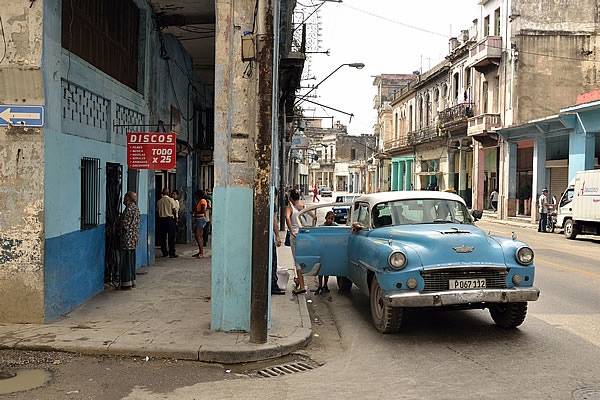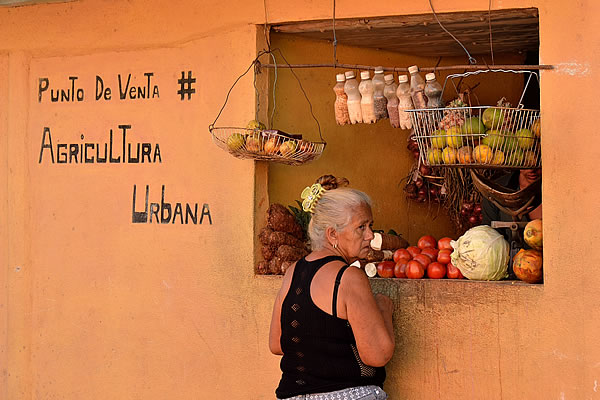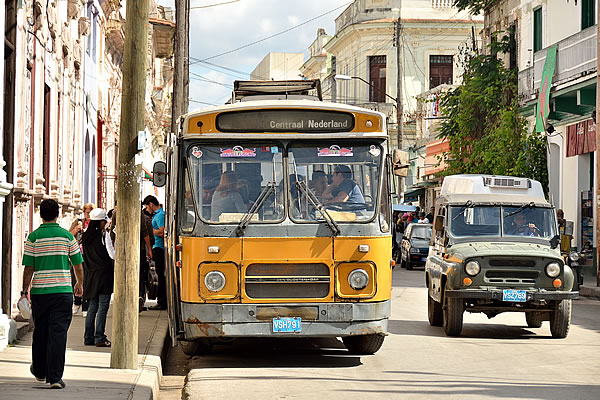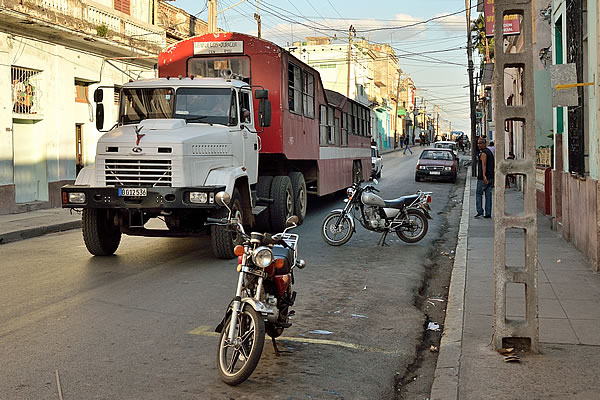English | Dutch |
|
| Time for a break for our Land Cruiser | |
Netherlands to Cienfuegos (Cuba), January 2015
|
|
| |
|
It is at the beginning of January when we take our backpacks again after we pushed our Toyota Land Cruiser in a shed for a break. We enjoyed travelling the previous one and a half year with our 1984 jeep very much, in where we drove to destinations in Eastern Europe, to Turkey, the Caucasian countries, Iran and Iraq. But now we take the backpacks again. Many people asked us why we do not drive with our jeep to Africa. The answer is very simple. At this moment we think it is not safe enough to go there. The eastern route will take us through Syria and also Egypt, two countries where we do not want to go at the moment. And also the western route has its complications. Mali is dangerous at the moment, and more south on Africa’s west coast is Ebola area. We also thought briefly about shipping the car to southern Africa, but the related costs are too high for us. So, we decided to travel with the backpacks again for a while. And that’s fun again. We lose some flexibility because we don’t have our own wheels anymore, but on the other side do we gain flexibility. Without a car it’s easier to visit destinations that are remote, like islands, and it’s easier to escape areas when a bad climate season kicks in. The Caribbean is a destination that’s difficult and expensive to visit by own car. And this is the destination that we chose for the next four months. But the European winter means high season in the Caribbean and that’s why we decided to book all our flights already. We booked the plane tickets well in advance, which means that we have ten flights in the area for a very, very good price. Cuba (one month) is our first destination, and after a stop-over of four days in the Cayman Islands, we fly for another month to Jamaica. From there we fly to Barbados, St. Lucia, St. Vincent & the Grenadines, Grenada and Trinidad & Tobago. At the end of April we fly to Florida, from where we take a boat back home to Europe. Another long standing wish: a transatlantic boat trip. |
|
 |
|
Havana is in many ways an open air museum |
|
On January 11th we fly from Düsseldorf to Cuba, a destinations that’s also already for a long time on our wish list. It is the country of the rumba, rum, Fidel Castro and his revolution, and of course the old American cars that are still very common in the streets. Some years ago, Fidel Castro moved aside because of his health, and since then his younger brother Raúl is running the country. And since Raúl is in power, things are slightly changing. People have more possibilities to own a small business, people are allowed to sell their house, the import restriction on cars in loosened, and the relationship with number-one enemy the US is improving. And that are major changes in this ultra-socialist/communist country. That’s why we decided to go now. It is possible that Cuba’s development path will change soon if the country opens up. And that is good for Cuba, but it will also mean that the country will change. And we love to see Cuba how it is right now, so that why we decided to go as soon as possible. And that is now. Our first destination in Cuba is Matanzas, a provincial town that is not on the tourist radar yet. And that is a good choice. This is the Cuba as we always thought that it was. No development has taken place since the revolution of 1959, and that means that many buildings are crumbling, the number of shops are still very limited and the amount of old American cars in the street is still significant. Not many tourists make it to Matanzas yet, and that means that the city is still pure Cuban. Only one hotel and a handful of casa particulars (rooms at private homes) accommodate the few travellers that decide to come. It was for us the perfect introduction to Cuba (see also our article and photo impression about Matanzas). |
|
 |
|
Most travelers say that the landscape around Viñales is the most beautiful area of Cuba |
|
| After our visit to Matanzas we take the ‘ancient’ electrical Hershey train to Havana. This train, built in the 1920s, is still as it was at that time. The same carriages, the same track and the same slow speed. It takes more than three and a half hours to bridge the 90 kilometres distance, but it is a scenic ride. Besides that, it a great way to see how locals are travelling. Havana is a very picturesque city. It is absolutely one of the most beautiful cities we ever visited. La Habana Vieja, the historical centre and main tourist area, lost some of its atmosphere due to the restoration activities. It is now mainly a tourist area with hotels, restaurants, bars and souvenir shops. That means that most of the traditional Cuban life has squeezed out of the area. And that is a pity. But if you look well, you can still find Cuban life also in this part of town. But for us, the absolute highlight of Havana was La Habana Centro. This is the commercial and residential heart of the city and this is the real Havana. This is where people work and live. Main commercial thoroughfares are inter-connected by small residential streets where people still live a huge part of the day on the streets. Old and crumbling, but architectural beautiful buildings, often from the beginning of the 20th century, lines the narrow streets. Old men are playing domino between the worn out American cars, while children play soccer or baseball. Shops are still small and limited and that means that people buy their goods from small holes in the wall called ‘tienda’ (Spanish for shop) or from a street seller who sells bread, milk or vegetables from a box on the back of his bike (see also our article and photo impression of Havana). After Havana we travel to Viñales, a small town in a national park that has the same name. The area is seen as one of the most beautiful landscapes in Cuba. The area is indeed beautiful, but not spectacular in our opinion. But the area is also famous for its tobacco plantations and the accompanying cigar factories. And this attracts also a lot of tourists, mainly tour groups. This all made Viñales a very touristy place where all activities are related to tourism. The place where you will stay will do everything to get the most out of you (money wise), and that makes Viñales in some way an annoying place. After Viñales we visited another mass-tourism destination in Cuba, called Trinidad. This well-preserved and restored colonial town is a magnet for tourists. It seems that all activities in this town are related to tourism. More than 500 Casa Particulars (private houses where rooms are for rent) can be found in this small town, and that says it all. So called ‘jineteros’, young men hanging around in the streets to sell you something for a commission, are a pain in the ass. ‘Taxi’, ‘private room’ and ‘horse ride’ are words you hear constantly in the city. There is also a monopoly kind of agreement on the sale of water city wide. Five litre bottles that are available everywhere in Cuba aren’t available here, while a 1.5 litre bottle that costs 0.70 CUC (= 0.70 US$) in the rest of Cuba costs a shocking 2 CUC (2 US$) in this town. In our opinion is Trinidad a place for a quick look, but an even quicker departure. We decide to leave the tourist trail as much as possible. We visit the cities Sancti Spiritus, Santa Clara and Cienfuegos, which are ‘normal’ Cuban cities again. We are not in Cuba to see a well restored town, to visit a touristy cigar factory, or to ride a horse in the mountains. We came to Cuba to experience Cuban life. And that is what still can be found in these three provincial cities, however, we have to say that also Cienfuegos is touristy. But due to its size, it is easy to avoid the touristy area around the restored central square. We are now three weeks in Cuba and like it very much. Matanzas and Havana were highlights so far, but we were also surprised by the huge number of tourists. Most tourists are visiting the same places, so you can avoid the tour groups if you stay away from these places. But it is not easy to go off the beaten track, because the government want you to stay on it, for example by making it difficult/impossible for tourists to travel on public buses and to sleep at non-licensed places. But still, Cuba is a great place to visit. |
|
 |
|
A small hole-in-the-wall shop in Trinidad |
|
 |
|
Street scene in Sancti Spiritus |
|
 |
|
An old Dutch city bus still in use in Santa Clara |
|
 |
|
This type of truck-bus is still common in Cuba |
|
 |
|
A Cuban and his bird in Cienfuegos |
|
| <Previous weblog> | |